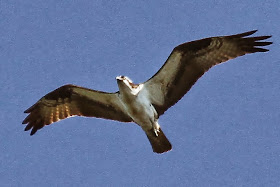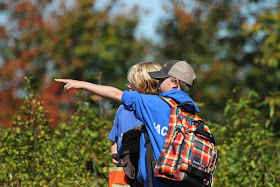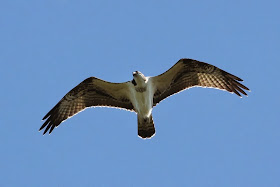 |
| Osprey migrating over Putney Mountain in SE Vermont |
She saw an Osprey, also known as the Fish Hawk. With its recovery from the devastation caused by DDT, the Osprey is again a common bird along the New England coast, and may be seen anywhere in Vermont where there is water - along our rivers, lakes, and large ponds.
The Osprey’s diet is almost exclusively fish, and from what I have been able to determine, almost exclusively fresh fish. It hovers 30-100 feet above the water surface looking for fish near the surface. Finding its prey, it plunges to the water, sometimes completely submerging save for wing tips. Terres in Encyclopedia of North American Birds completes the description of the Osprey’s fishing: “Rises from water with fish gripped in both feet, pauses in midair to shake water from plumage, and to arrange fish with head pointed forward, which reduces its resistance to air, flies with it to habitual perch to eat or to nest to feed young. Reported to carry fish up to 4lbs or more.” This dull description only hints at the excitement generated when you are able to watch the real thing.
 |
| Osprey hunting over Texas wetland |
The Osprey is the only bird which fishes in this manner. Gulls plop on the surface. Many aerial sea birds, like pelicans or gannets, plunge dive, capturing fish in their beaks. The Bald Eagle, also a “fish hawk,” plucks fish near the surface with its talons.
The Osprey and the Bald Eagle pose interesting contrasts. The Osprey rarely eats dead fish; the Bald Eagle enjoys dead fish, and dead anything else. The Osprey is a tireless fisher. It will consume its catch, then go hunting for more. The Bald Eagle does as little work as possible. When in the mood for fresh meat, rather than carrion, it is content to let the Osprey catch a fish and then steal it.
 |
| Osprey feeding in a New Jersey salt marsh |
An older naturalist, like Edward Forbush, always wrote of the benefit or harm that a particular bird posed to humans. In contrast to many other hawks, Forbush could write of the Osprey that all “the evidence available points to the conclusion that the Osprey is harmless to poultry, birds and game, and that most of the fish that it takes are species of little value to mankind. Fishermen usually welcome it as a guide to good fishing. All things considered, this great, handsome, picturesque and interesting bird must be regarded as a subject for perpetual protection.”
In the nineteenth and early twentieth centuries, an even greater contrast in attitude was found among coastal farmers. Where most people in those times considered hawks vermin to be exterminated (most hawks, given the opportunity, would take a barnyard chicken), coastal farmers and fishermen actively protected Osprey. They watched Ospreys aggressively protecting their nests, eggs, and young. The farmers’ young chickens ran free during the summer; it was assumed that the Osprey protected the chickens from other hawks. Coastal farmers were anxious to have Osprey nesting close to their farmyard, so they set up nesting platforms for them - a tall pole with a wheel fixed on its top.
 |
| Osprey "home repairs" in May at Forsyth NWR, NJ |
However, John James Audubon was the more complete observer of the Osprey. In the mid-nineteenth century he described the Osprey, or Fish Hawk as he knew it, as having a mild disposition: “Not only do these birds live in perfect harmony together, but they even allow other birds of very different character to approach so near to them as to build their nests of the very materials of which the outer parts of their own are constructed. I have never observed a Fish Hawk chasing any other bird whatever.”
He also debunks the coastal farmers belief that the Osprey protected the barnyard chickens from other hawks. Rather than staying away from the Ospreys, the other hawks simply went away; they went inland “for the purpose of rearing their young in security.” When the shorebirds and waterfowl returned to the coastal marshes, the other hawks returned as well. By then, the Osprey had completed its nesting and had begun moving south.
 |
| Osprey aerie atop a pinnacle in Grand Canyon of the Yellowstone |
The Osprey is a unique bird of prey. It belongs to the Order: Falconiformes - the diurnal birds of prey. But the Osprey has been on its own evolutionary path for a long time. Taxonomic classification constantly changes. At one time the Osprey was in a Family by itself; the other Families being Hawk Family and Falcon Family. Current classification puts it in a sub-Family of the Hawk Family, making it a little more closely related to the hawks and eagles than to the falcons, but not by much. It is the only member of its sub-Family.
The point is, there are things about the Osprey that are unique among the diurnal birds of prey. For example, the Osprey has long, strong claws, curved about one-third of a circle. The claws are round. The toes are equal length. The lower surface of the toes are covered with spicules (small, bony spines) which help hold slippery fish. The outer toe is reversible (like an owls’) so that it can hold prey with two toes in front and two in back. Its plumage is compact which reduces wetting when it plunges into the water. These are only some features of the Osprey which make it unique among the hawks.
The scientific name for the Osprey is Pandion haliaetus. The genus name refers to the complicated Greek legend of Pandion, king of Athens, and his two daughters. The rules of taxonomic nomenclature require that once a name has been applied, we are stuck with it, even if it is wrong. This is one of those cases; there is no reasonable, or even unreasonable, reason for applying the name “Pandion” to the Osprey. The best that can be said, is that this was a flight of mythological exuberance. The species name, haliaetus, does a little better; it means “sea eagle” from the Greek.
 |
| Osprey feeding young |
Good birding!





















































